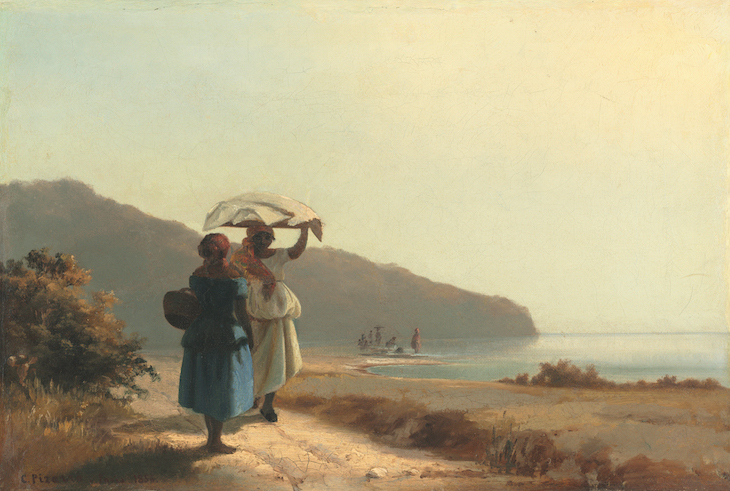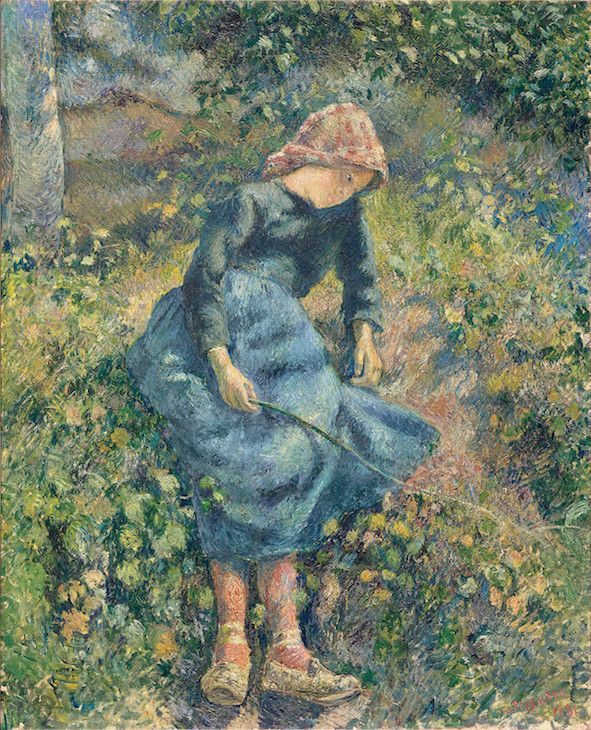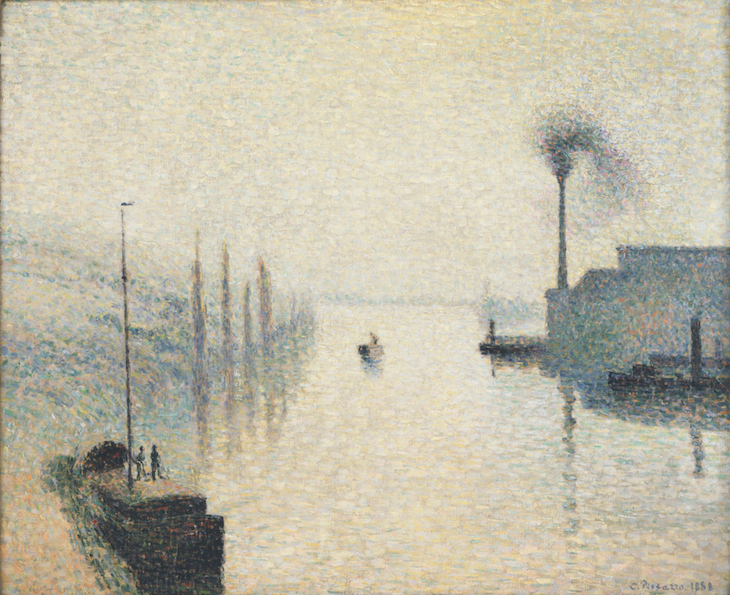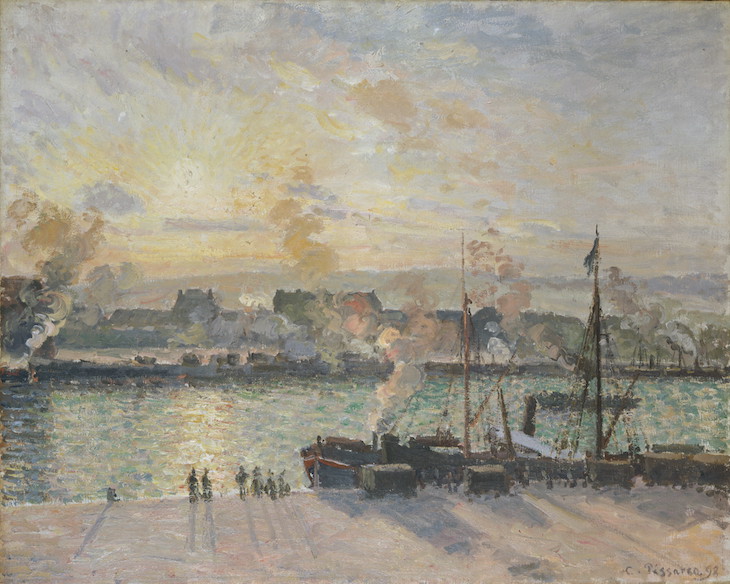From the April 2017 issue of Apollo: preview and subscribe here.
If asked to name the key figure in Impressionism, few people today would nominate Camille Pissarro (1830–1903). Yet to his contemporaries this quiet revolutionary was the unifying force behind the movement that he had helped to launch with the first Impressionist exhibition in 1874; he was the only member of the group to show in all eight Impressionist exhibitions. ‘We learned everything we do from Pissarro,’ said Paul Cézanne in the 1890s. ‘It’s he who was really the first Impressionist.’
Born in 1830 on the island of Saint Thomas in the Danish Antilles to a Portuguese-Jewish father and a French-Jewish mother, Pissarro never held French nationality. Although he was sent to school in Passy at the age of 12, his native landscape was Caribbean. The Musée Marmottan Monet reminds us of this in ‘Camille Pissarro: The First of the Impressionists’, the artist’s first retrospective in France for 36 years, by hanging the tropical beach scene Deux femmes causant au bord de la mer (1856) at the entrance of the exhibition. For this French Impressionist, France was initially a foreign country whose light and landscape he viewed through unfamiliar eyes.
Deux femmes causant au bord de la mer (1856), Camille Pissarro. National Gallery of Art, Washington, D.C.

The first French landscapes Pissarro submitted to the Salon in the 1860s were influenced by Camille Corot, whose studio he had attended in 1857; Corot’s slanting late summer afternoon sunlight seems to strike the huddle of white houses overlooking the allotments in Le Jardin de Maubuisson, Pontoise (c. 1867). After a move to Louveciennes in 1869, where he invited the younger Monet to paint alongside him, it is Monet’s winter light that appears to colour Pissarro’s snow scene of La Route de Versailles, Louveciennes (1870), although the two artists’ approaches to their snow scenes are so symbiotic that it’s impossible to say who influenced whom.
In 1872, now living in the market town of Pontoise, Pissarro invited another former fellow student from the Académie Suisse, Cézanne, to join him. Nine years younger than Pissarro, Cézanne looked up to the more experienced artist as ‘a man you could consult about matters as if he were God the Father’. Cézanne began by copying Pissarro’s large painting Louveciennes (1871) as an exercise in lightening his palette; four years later, Pissarro’s Chemin montant, rue de la Côte-du-Jalet, Pontoise (1875) – painted after Cézanne’s inclusion in the first Impressionist exhibition – would bear the imprint of his protégé’s geometric vision.
Jeune fille à la baguette (La bergère) (1881), Camille Pissarro. Musée d’Orsay, Paris

When painting alongside likeminded artists, Pissarro was as ready to learn as he was to teach. In the 1880s he would take another aspiring young artist, Paul Gauguin, under his wing, inviting him to show in the sixth Impressionist exhibition in 1881. It was during the period they spent painting together that Pissarro brought the peasants who had always peopled his landscapes into close focus, making them the principal subject of paintings such as Jeune fille à la baguette (1881) – an example Gauguin would later follow in Brittany.
Pissarro’s move with his family to the remote Normandy village of Éragny-sur-Epte in 1884 brought these fruitful painting partnerships to an end. With no rail link, he was plunged into a rural past untouched by agricultural modernisation. ‘I think about the weather, the clouds, the sun, the leaves growing slowly and the blossom on the fruit trees,’ he enthused, though by 1893 he was complaining of summer’s ‘fat green monotony’ and his impatience for ‘the sensations [to] revive in September and October’. Those sensations are vividly captured in Automne, peupliers, Éragny (1894), with its radiant camouflage of autumn foliage screening the russet cows in the field behind.
La Seine à Rouen, L’Île Lacroix, effet de brouillard (1888), Camille Pissarro. Philadelphia Museum of Art

If Pissarro was in danger of vegetating, he was shaken out of his bucolic languor in 1886 by a visit to the 26-year-old Georges Seurat’s studio, in which he saw Un dimanche après-midi à l’île de la Grande Jatte. At the ripe age of 56 he converted to Divisionism, hailing the movement as ‘a new phase in the logical march of Impressionism’ and reworking his large canvas La cueillette des pommes (1886) in accordance with its principles of optical mixing by juxtaposing dots of pure colour on the canvas. In the eighth and last Impressionist exhibition, his own experiments in the technique were hung with those of Seurat and Paul Signac in a separate room. La maison de la sourde et le clocher d’Éragny (1886), with its regimented dots, shows Pissarro sticking religiously to the rulebook, but the mechanistic approach went against his grain. By September 1888 he had decided that ‘the dot is meagre, lacking in body, diaphanous, more monotonous than simple’. Still, the lessons the technique taught him about colour are abundantly clear in the luminous La Seine à Rouen, l’île Lacroix, effet de brouillard (1888): he had learned how to breathe life into greys.
Those greys came into their own in the 1890s in the late paintings of the Normandy ports that, along with views of Paris, would dominate the last decade of Pissarro’s life. Prevented by an eye problem from painting outdoors, Pissarro took to renting hotel rooms with high viewpoints from which he painted in series, panning across the view from his window in separate paintings that, if overlapped, would form a panorama. In these urban settings, the individual figures that had always animated his rural landscapes became a swarm of pullulating humanity. Everything was in motion: people, carriages, steam from tugs, smoke from chimneys. His aim was ‘to give an idea of the movement, activity and atmosphere of the port packed with smoking boats, bridges, chimneys and the city in the mist, the fog, the setting sun’. In paintings such as Le Pont Boieldieu à Rouen, soleil couchant, fumées (1896), he succeeded spectacularly.
‘To speak of M. Camille Pissarro is a difficult task,’ wrote a reviewer of the eighth Impressionist exhibition in which the mature artist embraced Divisionism. ‘This is a veteran of struggle, a master who continues to make progress.’ Like his urban crowds, Pissarro never stood still; his art was as mobile as the weather effects he so vividly captured. The 60 well-chosen works in this overdue survey can give only an idea of the artist’s extraordinary range.
‘Camille Pissarro: The First of the Impressionists’ is at the Musée Marmottan Monet, Paris, until 2 July.
From the April 2017 issue of Apollo: preview and subscribe here.



